Introduction
Robotic Process Automation (RPA) is revolutionizing the business world by automating mundane tasks and streamlining processes for enhanced efficiency and accuracy. From healthcare to retail, RPA is making a significant impact across industries. However, successful RPA implementation requires careful planning and ongoing monitoring to ensure stability and maximize the benefits of improved productivity.
Recent studies highlight the tangible advantages of intelligent automation, with companies investing in RPA seeing significant revenue growth. By leveraging RPA’s capabilities, organizations can save time and resources while setting the stage for continued innovation and competitive advantage. In this article, we will explore the role of RPA in modern businesses, the benefits it offers, common applications, tools and technologies for implementation, and best practices to ensure successful integration.
We will also delve into advanced techniques, cognitive automation, and the future trends and predictions for RPA. Join us on this journey to discover how RPA can transform your organization’s operations and drive success.
The Role of RPA in Modern Businesses
Robotic Process Automation (RPA) is reshaping the landscape of business operations by automating mundane and repetitive tasks. From data handling to generating reports, RPA bots can transform a multitude of procedures, streamlining them to enhance efficiency and accuracy. The key to successful RPA implementation lies in thoughtful planningâidentifying the appropriate manual processes for robotization and discerning the inefficiencies that RPA can rectify.
Case studies from the healthcare sector illustrate the significant impact of RPA. For instance, Epic and Cerner, leaders in electronic health record management, rely heavily on RPA. Epic serves over 250 million patients and is trusted by more than 250,000 healthcare professionals, reporting impressive annual revenues. Cerner’s reach extends to 27,000 healthcare facilities globally, indicating the vast potential of RPA in scaling operations and managing complex data across borders.
However, the shift to mechanization is not a set-and-forget affair. According to the CTO and Co-Founder of Reveille Software, continuous monitoring, management, and upgrades are necessary for the implementation of AI and other technological advancements. This human partnership ensures stability and maximizes the benefits of improved efficiency and productivity. Intelligent synergy, a combination of RPA and AI, propels companies toward digital transformation, as it allows for the enhancement of processes and more informed decision-making.
Recent studies highlight the concrete benefits of intelligent technology. A Forrester Research study revealed that companies that put resources into smart mechanization observed a 73% expansion in income of overall net present value (NPV) advantage and a compound annual growth rate (CAGR) of 5.4% over three years. This data highlights the critical role of RPA and AI in driving economic growth.
In conclusion, RPA is not simply a tool for automating tasks but a strategic asset for modernizing business operations. By leveraging RPA’s capabilities, companies can not only save time and resources but also set the stage for continued innovation and competitive advantage.
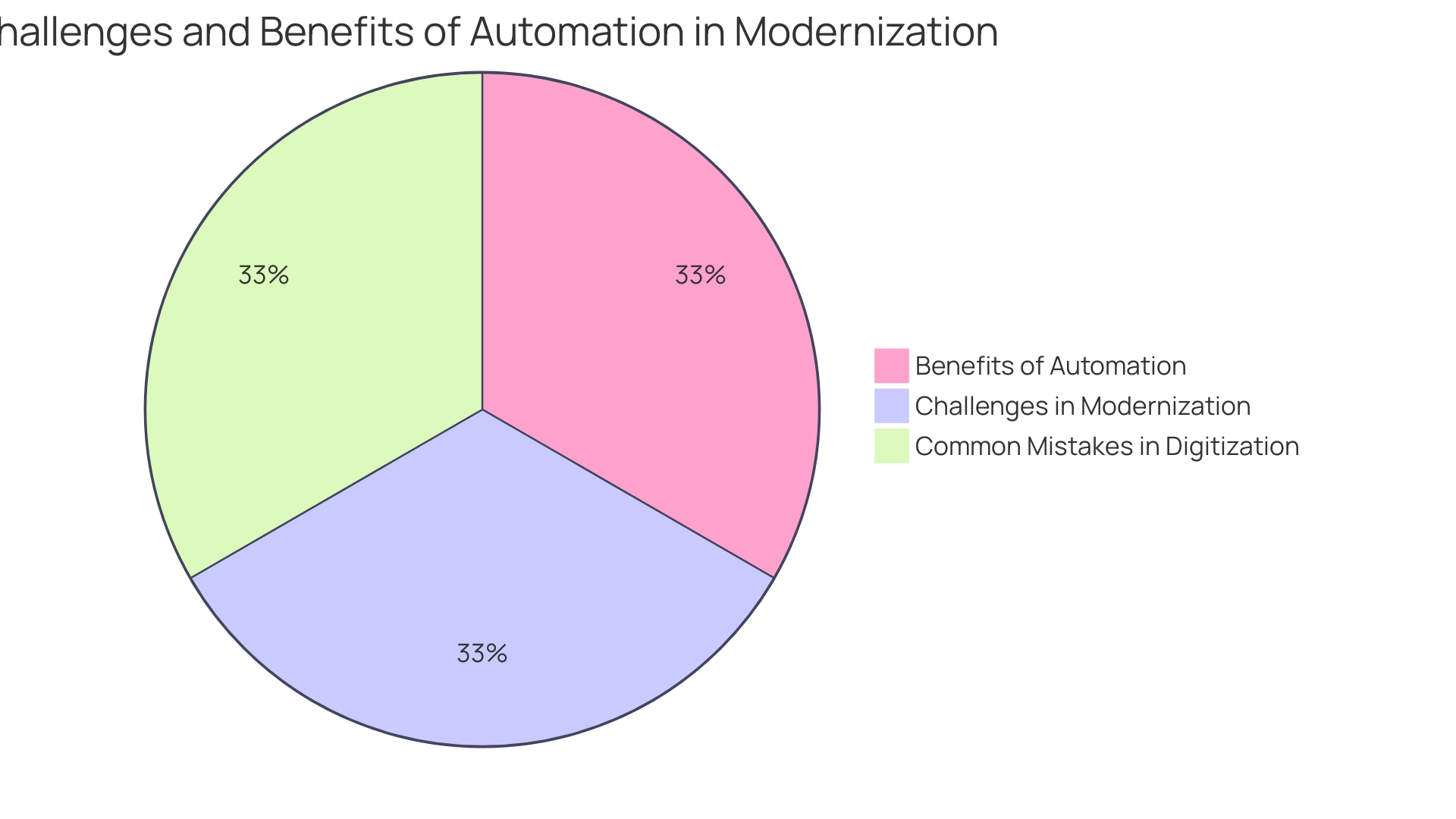
Benefits of RPA
Robotic Process Automation (RPA) has become a transformative force for businesses worldwide, offering a multitude of benefits that extend far beyond simple cost savings. By integrating RPA, organizations in various industries, such as healthcare, have reported significant enhancements in productivity. For instance, with the adoption of RPA, healthcare professionals can shift their focus from managing electronic health records to providing better patient care, as evidenced by the widespread use of Epic and Cerner systems which collectively manage a substantial portion of health records globally.
Additionally, RPA is not only focused on automating tasks; it’s also aimed at enhancing business procedures. Before putting it into action, it is essential to carefully assess which manual operations are ready for automation and to identify inefficiencies that RPA can tackle. This ensures a strategic approach that maximizes time and cost efficiency when integrating RPA software.
The precision and uniformity delivered by RPA are unmatched, with the tool reducing the chance of human mistake, resulting in more dependable outcomes in operations. This has been a game-changer, particularly in document management, where technologies like OCR have been complemented with AI to extract data more effectively, thereby streamlining processes regardless of whether they are executed by robots or humans.
The future of business lies in the symbiosis between digital and human workforces, creating a collaborative ecosystem that leverages the strengths of both. While mechanization enhances efficiency and productivity, it is the human touch that ensures stability, creativity, and emotional intelligence. Small businesses, in particular, can leverage RPA to maintain strong customer relationships by expediting responses and delivering accurate information, thereby fostering customer satisfaction and loyalty.
Statistics reveal that companies embracing intelligent automation experience considerable revenue growth and a compound annual growth rate (CAGR), underscoring the tangible value that RPA can contribute to an organization’s bottom line. However, achieving these results requires a nuanced approach, avoiding common pitfalls such as overhauling tools without clear objectives or poor stakeholder engagement. Instead, a successful RPA implementation involves setting achievable goals, choosing the right tools, and managing change effectively. By doing so, businesses can unlock the full potential of digitization, as demonstrated by a semiconductor foundry that standardized its best practices to accelerate market readiness, reduce costs, and improve project management and technology.
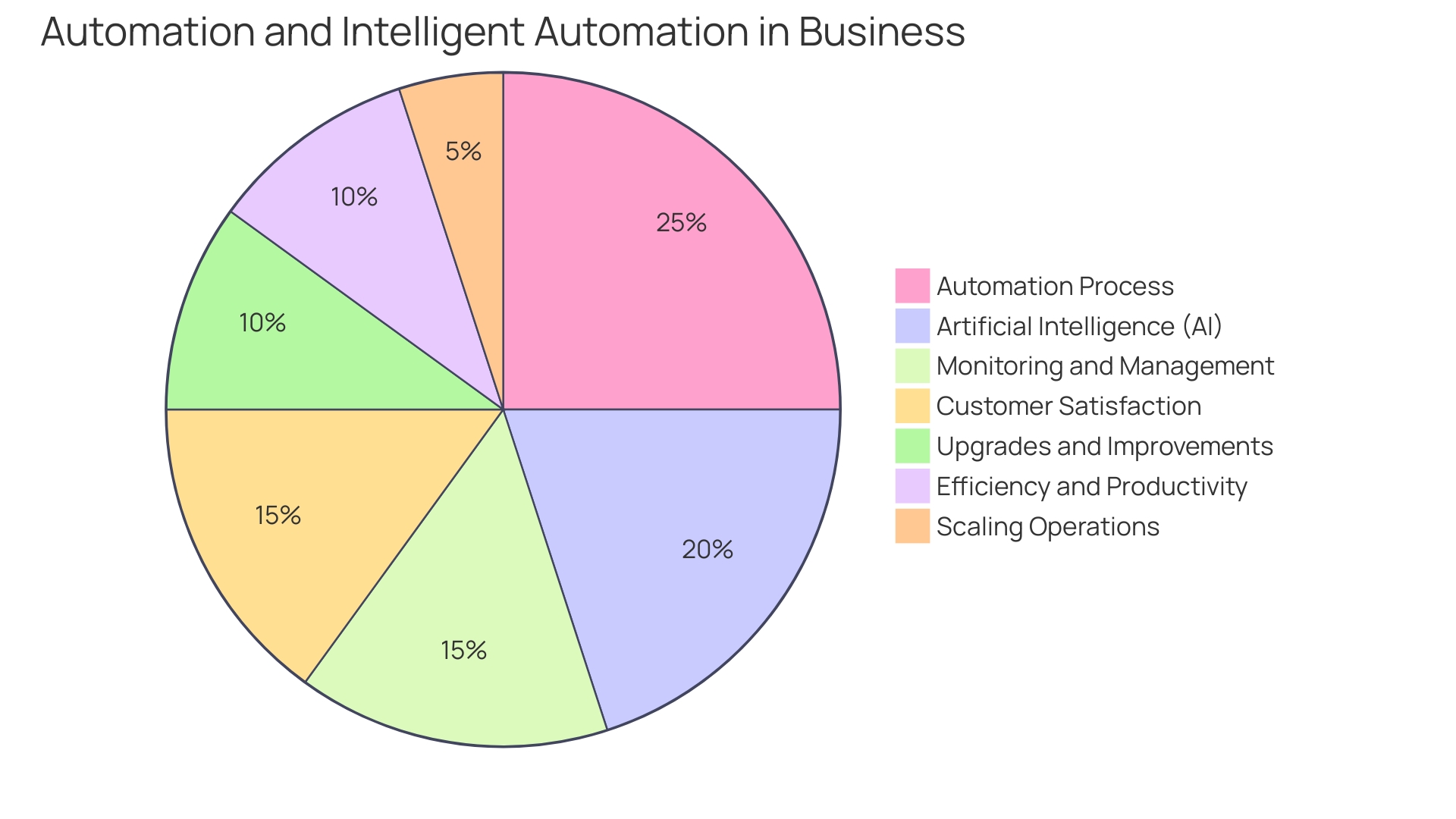
Common Applications of RPA
Robotic Process Automation (RPA) is revolutionizing the way businesses handle routine tasks across various sectors. A prime example is data migration, a task that can be cumbersome and error-prone when done manually. RPA provides a smooth substitute, as shown by Check Technologies, which utilizes the Check Data Platform to conduct intricate data analysis, improving their decision-making with tools like Airflow.
In customer service, RPA is instrumental in handling repetitive inquiries, allowing staff to focus on more complex issues. Delivery Hero, a global delivery platform, utilized RPA to address the challenge of account lockouts among its vast employee base. By automating the identity verification and account recovery process, the company significantly reduced the downtime experienced by employees, enhancing overall productivity.
The retail sector is also benefiting from RPA, with innovations such as the checkout-free store in Dublin Airport, which uses a blend of cameras and weight-sensored shelving to detect purchases for a frictionless shopping experience. This application of RPA not only improves customer satisfaction but also streamlines inventory management.
RPA’s impact on the HR domain is equally transformative, particularly in onboarding new hires. It streamlines administrative tasks, allowing HR professionals to engage more meaningfully with employees. The integration of RPA in supply chain management is another testament to its versatility, where it optimizes inventory levels and facilitates timely delivery of goods.
Statistics from a global survey of 1,639 automation professionals highlight the growing acceptance and integration of AI with RPA, indicating a shift towards more intelligent automation. The survey, conducted by UiPath, emphasizes the importance of RPA in the current business landscape and its potential to enhance operational efficiency.
Automation is not just about embracing innovative approaches; it’s about making strategic choices that yield high returns on investment. While undertaking the path of digital transformation, leaders should thoroughly evaluate which procedures to automate and the possible advantages, guaranteeing that RPA aligns with their overall objectives for efficiency and productivity.
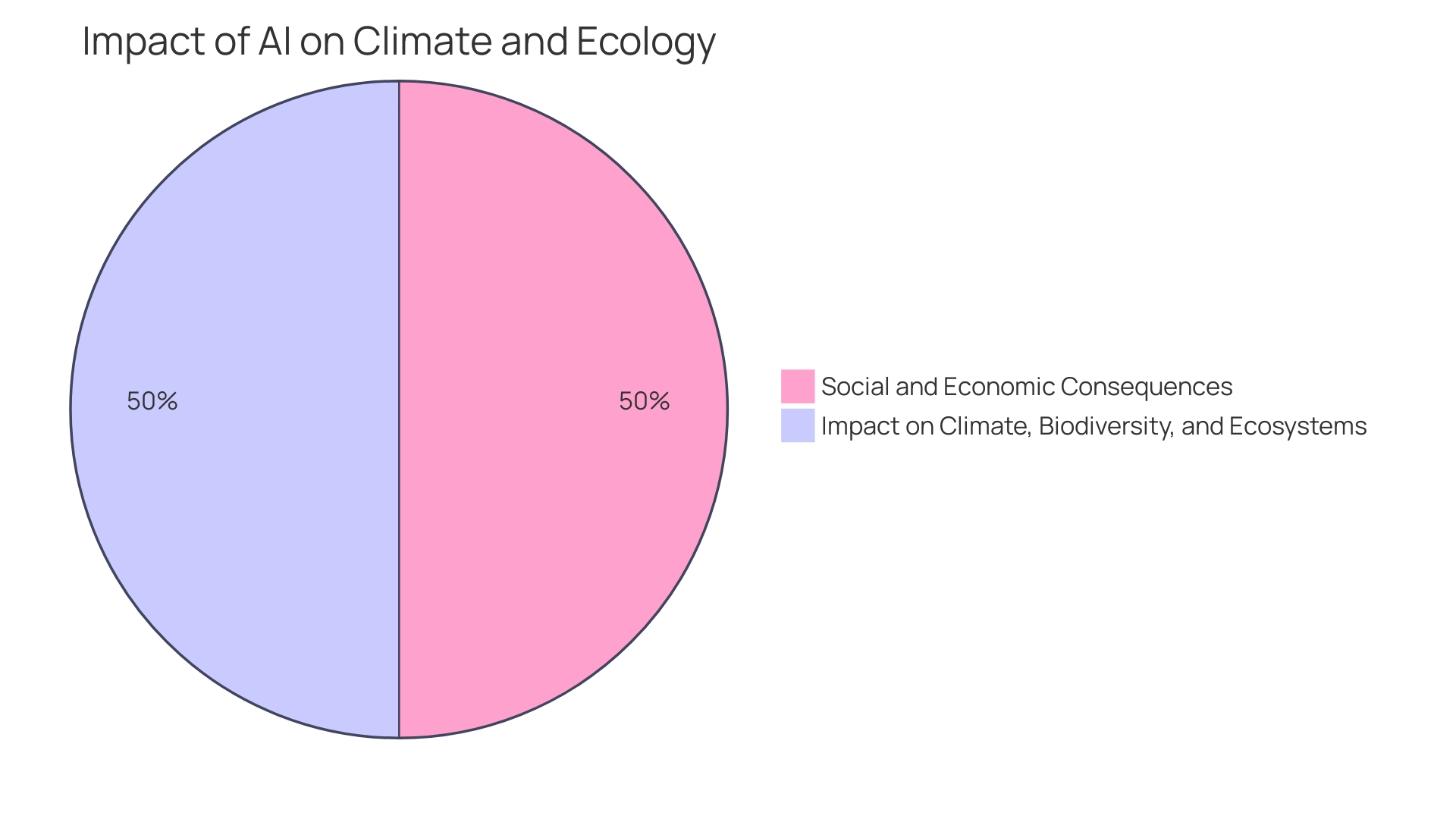
Tools and Technologies for RPA
Selecting the optimal tools for Robotic Process Automation (RPA) is a critical step towards modernizing operations and enhancing productivity. With a plethora of software platforms available, it’s essential to choose ones that not only facilitate the creation and management of bots but also integrate advanced AI technologies to amplify RPA capabilities. Considering the current business landscape, where 70-80% of companies still rely on spreadsheets for a variety of tasks, the transition to more sophisticated tools can be both an upgrade and a challenge.
To successfully navigate this journey, organizations must conduct a comprehensive evaluation of their manual procedures to determine which are ready for automation. This assessment should identify inefficiencies that RPA can target, and consider the integration time and costs for each procedure. For example, within the NHS, a digital-assurance procedure ensures that new technologies meet stringent standards before adoption, including verification that the proposed solutions are secure, appropriate, and compliant.
As the cooperation between human and digital workforces becomes more crucial, it’s essential to strike a balance between mechanization and human involvement. This balance is key to leveraging the full potential of a combined workforce, where creativity and emotional intelligence complement the precision of digital tools.
In the realm of development, AI tools are revolutionizing the way code is crafted, offering virtual assistance that can detect errors early and even generate code. This change in perspective is backed by a worldwide study of 1,639 professionals in the field of automated technology, which emphasizes an increasing willingness to incorporate AI into work procedures.
In conclusion, the journey to effective RPA implementation is paved with strategic decisions, from selecting the right tools to ensuring they fit into a well-balanced human-digital collaboration. Organizations are encouraged to delve into comprehensive assessments, embrace the evolving role of AI, and adopt a mindset of continual adaptation to stay at the forefront of operational efficiency.
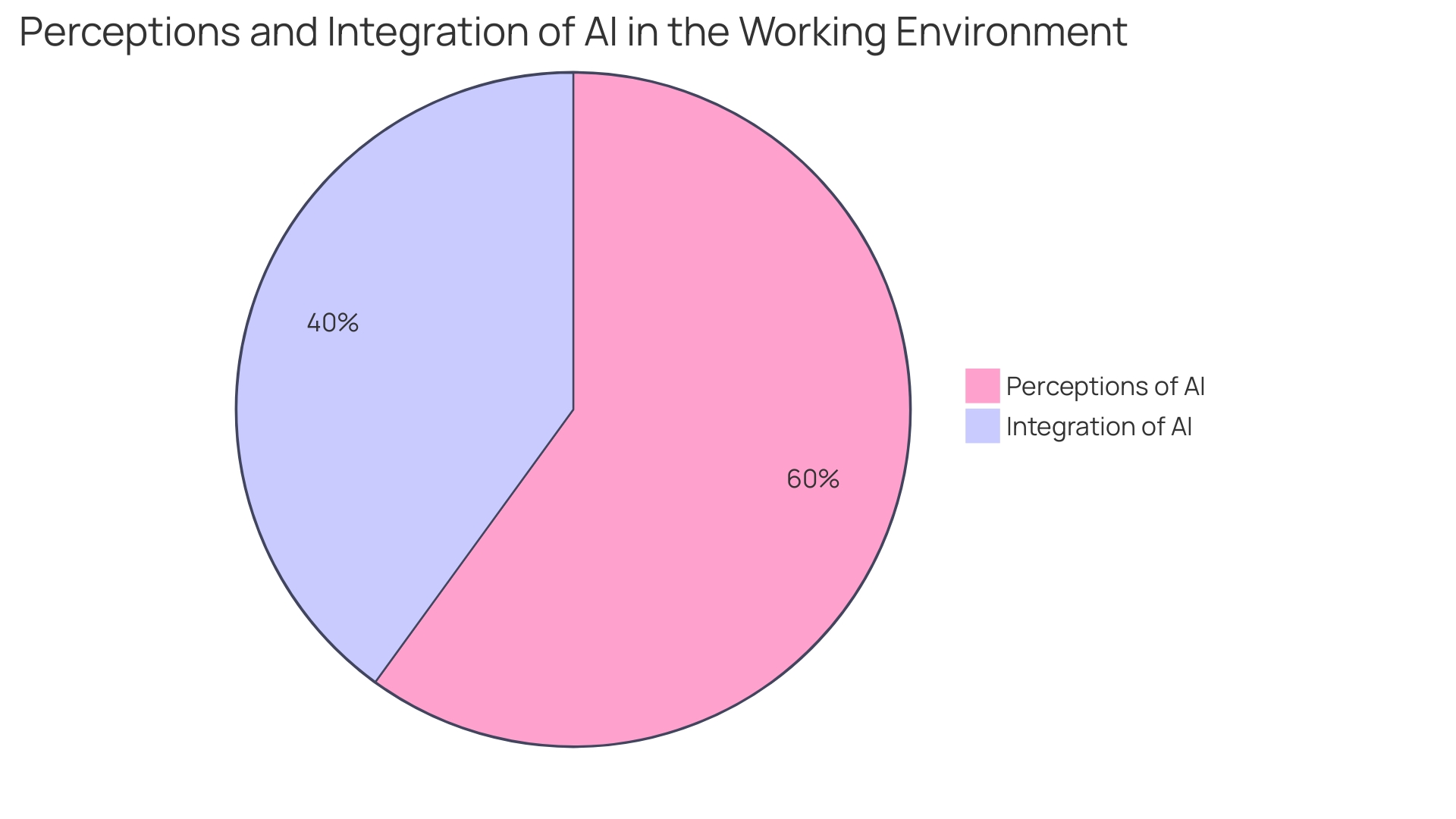
Getting Started with RPA: Basic Steps
Embarking on Robotic Process Automation (RPA) necessitates a strategic methodology, commencing with an in-depth exploration of the procedures you intend to automate. It’s crucial to identify which manual tasks are ready for mechanization and to identify the inefficiencies they hold. The act of discernment is not just a simple checklist; it requires a thorough analysis of time and financial investment to effectively integrate RPA software.
After identifying the tasks that need to be automated, the subsequent stage involves creating the bots that will execute the tasks. But it doesn’t stop there. As the CTO and Co-Founder of Reveille Software puts it, the process of automating tasks is not a ‘set it and forget it’ system; it requires continuous monitoring, management, and updates—a true partnership between humans and advanced systems to ensure ongoing stability and efficiency.
In the healthcare sector, for example, the introduction of digital technologies follows a stringent ‘digital-assurance process’ to ensure new tech meets high security and compliance standards. This meticulous approach is a fine exemplar for any RPA implementation, reinforcing the necessity of thorough assessment before deployment.
The integration of AI in public services, such as UK’s transportation systems, has shown the potential of using AI to enhance safety and operational efficiency. However, it has also highlighted the importance of addressing ethical considerations and upholding privacy standards.
Data from a worldwide survey of 1,639 professionals in the field of automated processes, conducted by UiPath, disclose the community’s perspectives, emphasizing the significance of support initiatives and gatherings to nurture development in the field. For leaders in operations, these insights are invaluable for understanding workforce dynamics and integrating AI into work activities.
In brief, establishing the foundation for RPA entails recognizing suitable procedures, assessing inefficiencies, creating bots, and a dedication to continuous supervision. With a strategic vision and alignment on expectations and timelines, your organization can embark on a journey towards becoming an AI-enabled enterprise, ready to reap the benefits of advanced technology while navigating its complexities.
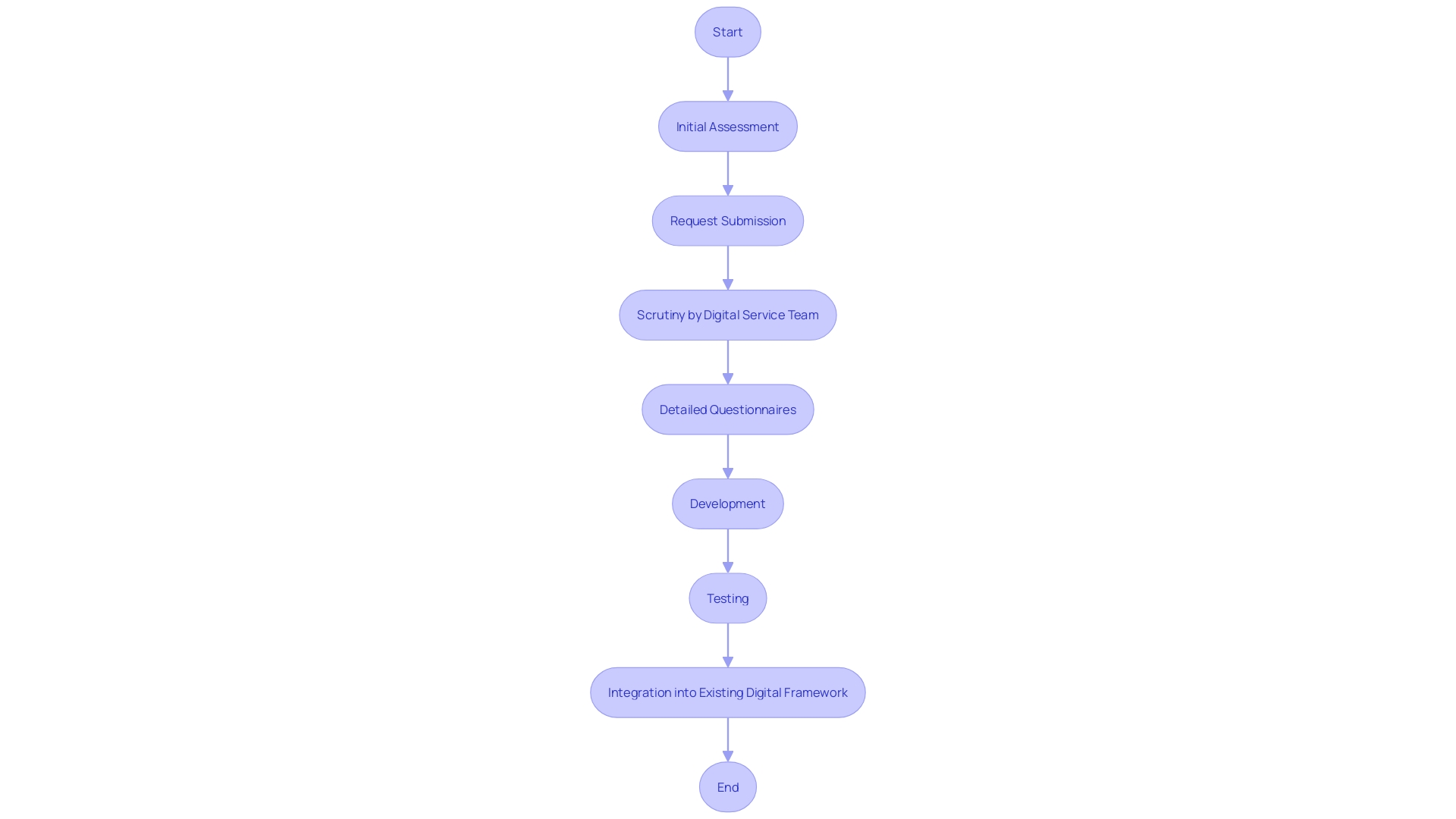
Automating Desktop Applications
Harnessing the transformative power of Robotic Process Automation (RPA), businesses can elevate their desktop applications to new heights of efficiency and accuracy. Imagine the leap in productivity by automating routine data entry in Excel or seamlessly interfacing with legacy systems—this is no longer the realm of imagination but a tangible reality with RPA.
Leveraging tools like .NET and Selenium, developers can craft robust applications that not only automate tasks but also incorporate the cutting-edge intelligence of AI, such as ChatGPT, to summarize content or facilitate interactions. For instance, establishing a project in. NET sets the foundation for a system that can automate and streamline intricate procedures, from initiating customer dialogues to capturing detailed invoice data.
A case study from the Department of Electronic & Electrical Engineering showcases a transformative approach to managing personal tutorials. By automating attendance recording and feedback collection, the department significantly enhanced its operational efficiency. Likewise, professionals in the field of automated systems, as emphasized in recent studies, experience great fulfillment in their professions, indicating the beneficial influence of RPA on the labor force.
Forward-thinking companies like Tungsten Automation offer a sneak peek into the future of operational procedures. By adopting their solutions, businesses can offer enhanced customer experiences and access services anytime, anywhere, fostering customer satisfaction and loyalty. As mechanization continues to evolve, it remains a collaboration between human oversight and technological prowess, ensuring that efficiency and productivity reach their maximum potential.
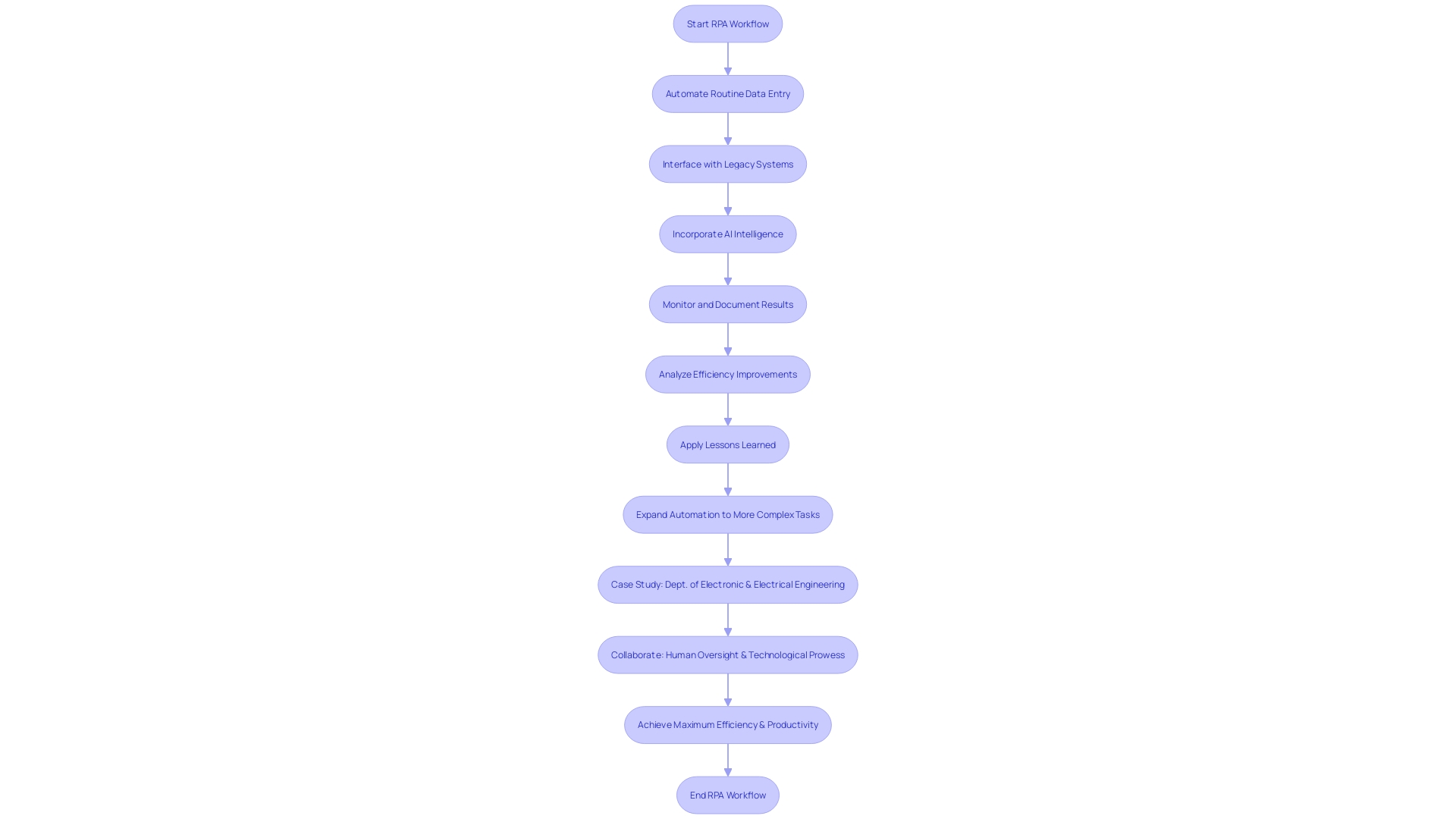
Integrating with Web Applications
Harnessing the synergy of Robotic Process Automation (RPA) with web applications heralds a new era of efficiency for businesses. Integrating RPA into web applications encompasses a range of methodologies, from traditional screen scraping to contemporary API-based integration. Each approach carries its unique advantages, with screen scraping offering a quick and easy solution to automate interactions with the user interface, while APIs enable a more stable and direct communication channel with the application’s backend, fostering seamless data exchange and automation.
An example of this is the innovative approach adopted by Delivery Hero, a worldwide delivery platform, which automated the account recovery procedure for their extensive workforce. By integrating RPA into their IT systems, they significantly reduced the time employees spent locked out of their accounts, turning a 35-minute process into a swift, automated one. This not only improved their operational efficiency but also enhanced employee productivity.
Similarly, the .NET framework, complemented by tools like Selenium and the intelligent capabilities of ChatGPT, creates a robust environment for developing and deploying systems. These systems are designed to perform tasks such as summarizing email content automatically, demonstrating the transformative potential of combining RPA with web applications.
Moreover, the importance of creating an effective library of tools is echoed by industry thought leaders. As the technology landscape evolves, the implementation of intelligent mechanization becomes a critical factor for companies seeking digital transformation. Using RPA and AI, businesses can enhance procedures and make well-informed choices. It’s important to start small, automating less complex tasks, and then scale up, continuously monitoring and documenting results to ensure goals are met.
To navigate the complexities of integration, it’s essential to stay abreast of the latest trends and best practices in the field. As RPA and AI continue to revolutionize the way we work, the shift from searching for solutions to directly querying AI systems has become a significant time saver for developers. This allows for a more focused approach to implementing solutions that drive business forward.
In conclusion, the integration of RPA with web applications is not just about automating tasks; it’s about reimagining business workflows to unlock unprecedented levels of productivity and innovation. By following the examples set by leading organizations and leveraging the right tools and strategies, businesses can achieve a competitive edge in today’s digital landscape.
Advanced RPA Techniques
Expanding your RPA toolkit to include advanced techniques can significantly enhance your automation capabilities. By incorporating exception handling, your bots can intelligently manage unexpected events during execution, ensuring smoother operations. Conditional logic enables bots to make real-time decisions based on predefined criteria, thereby handling varying scenarios with ease.
Error recovery mechanisms are crucial for maintaining process continuity. They allow bots to recognize when something goes wrong and to take corrective action without human intervention. These advanced techniques are especially beneficial when dealing with unstructured data, which lacks a predefined format, making it more challenging to automate. Advanced RPA can identify patterns and extract relevant information from such datasets.
Moreover, dynamic web pages, which present content that changes based on user interaction, can be navigated efficiently with RPA tools that adapt to these changes. By utilizing frameworks like. NET in conjunction with libraries such as Selenium WebDriver and AI technologies like OpenAI, you can create robust systems capable of complex tasks like summarizing email content automatically.
A real-world example comes from a food and beverage company using UiPath, which utilized an AI-powered tool to inspect product labels for accuracy, saving time and reducing errors. This reflects the transformative power of integrating AI with RPA, commonly referred to as hyperautomation. It’s about elevating the traditional RPA by adding layers of AI, making it possible to automate more complex activities.
As demonstrated by a UiPath survey carried out from March to May 2023, with 1,639 professionals and students in the field of automated processes participating, there is an increasing tendency in organizations embracing AI to improve their strategies for automating processes. The ongoing enhancement and integration of advanced RPA capabilities are essential for success in the future of work, and remaining competitive requires embracing these evolving tools.
Cognitive Automation and AI Integration
Combining RPA with AI, particularly through technologies such as natural language processing and machine learning, leads to cognitive integration. This powerful combination enables the handling of complex tasks that require intelligent decision-making, transcending RPA’s traditional rule-based capabilities. Cognitive systems are part of the range of intelligent systems, which are broadly classified into AI-augmented, autonomous, autonomic, and cognitive systems. These classifications signify the varying complexities of how AI systems interact with human actions and their environments.
For example, AI-augmented systems may under certain conditions demonstrate autonomous behavior, but cognitive technology is particularly notable for its advanced capabilities. It takes cues from its environment and learns as it operates, making it an invaluable asset in the realm of intelligent operations. As an example, Lindy, an AI assistant, has been developed to automate diverse tasks across different applications seamlessly. Accomplishing this necessitated complex integrations with multiple apps and services, underscoring the advanced nature of cognitive solutions.
Moreover, the strategic implementation of cognitive technology involves establishing distinct timelines and success criteria. A well-articulated vision, such as becoming an AI-enabled enterprise and applying AI agents to core business activities, is essential. This strategic approach, coupled with the continuous improvement philosophy of hyperautomation, positions organizations to fully harness the potential of AI and prepare for the future of work. As smart mechanization systems keep progressing, they will progressively become a strategic necessity for businesses aiming to enhance procedures and enable their workforce.
Process Discovery and Optimization
The start of RPA in an organization starts with a thorough examination of existing procedures to discover improvement possibilities. During this stage, referred to as discovery of the procedure, it examines the complexities of existing workflows and establishes the foundation for the effective incorporation of technological advancements. It’s a pivotal step akin to the meticulous preparations Azure undertakes to ensure its platform thrives across diverse hardware and software environments, as highlighted by Mark Russinovich, CTO of Azure, in discussing optimization challenges.
To completely grasp the potential of RPA, it’s essential to optimize procedures by removing inefficiencies, such as bottlenecks, and reimagining workflows. This approach mirrors the optimization algorithms employed in complex cloud computing environments, where seeking near-optimal solutions within reasonable timeframes and resource constraints is standard practice.
Indeed, the transformative impact of RPA is not limited to simple task mechanization; it extends to fostering a more robust, agile, and cost-effective operational framework. As Coding Crafts, a leading software development company, emphasizes, the breadth of services including Blockchain, reflects the commitment to cutting-edge, secure, and transparent solutions. These advancements in technology and methodology underscore the importance of process optimization as the bedrock upon which the success of RPA initiatives is built.
Bot Orchestration and Workflow Management
As organizations expand their use of Robotic Process Automation (RPA), the orchestration of multiple bots and management of their workflows become pivotal to success. Bot orchestration is the art of coordinating various automated tasks to work in harmony, ensuring that each bot’s activity is synchronized with others to achieve optimal performance and efficiency. By utilizing sophisticated tools and techniques, companies can schedule bot activities, track their effectiveness, and swiftly address any issues that arise.
For example, Delivery Hero, a leading global delivery platform, faced a challenge with frequent employee lockouts, requiring substantial IT intervention that resulted in significant downtime. By implementing an intelligent system, they reduced the average recovery time dramatically, from 35 minutes to mere minutes, saving around 200 hours per month and enhancing overall productivity.
In the realm of social media, tech giant Snap, known for its popular app Snapchat, has leveraged Airflow to manage complex workflows associated with augmented reality features and its AI-powered chatbot, MyAI, which serves 150 million users. Snap’s journey from an initial idea to a consistently working prototype exemplifies the critical role of orchestration in delivering AI applications efficiently.
The strategic implementation of intelligent technology involves setting clear goals, creating a robust library of tools, and starting with smaller tasks to build up to more complex workflows. Consistent monitoring and documentation of results are essential to this procedure, providing valuable insights and learnings for future projects.
Moreover, the collaboration between human expertise and digital efficiency is essential for stability and growth. As highlighted by the CTO and Co-Founder of Reveille Software, the human collaboration is crucial to leverage the complete capability of advanced technologies like AI, guaranteeing they operate smoothly to improve efficiency and convenience.
In summary, the successful management of RPA initiatives requires a keen understanding of bot orchestration and workflow management. By drawing lessons from real-world applications and maintaining a balance between human oversight and automated efficiency, organizations can scale their RPA efforts and reap the benefits of enhanced operational productivity.
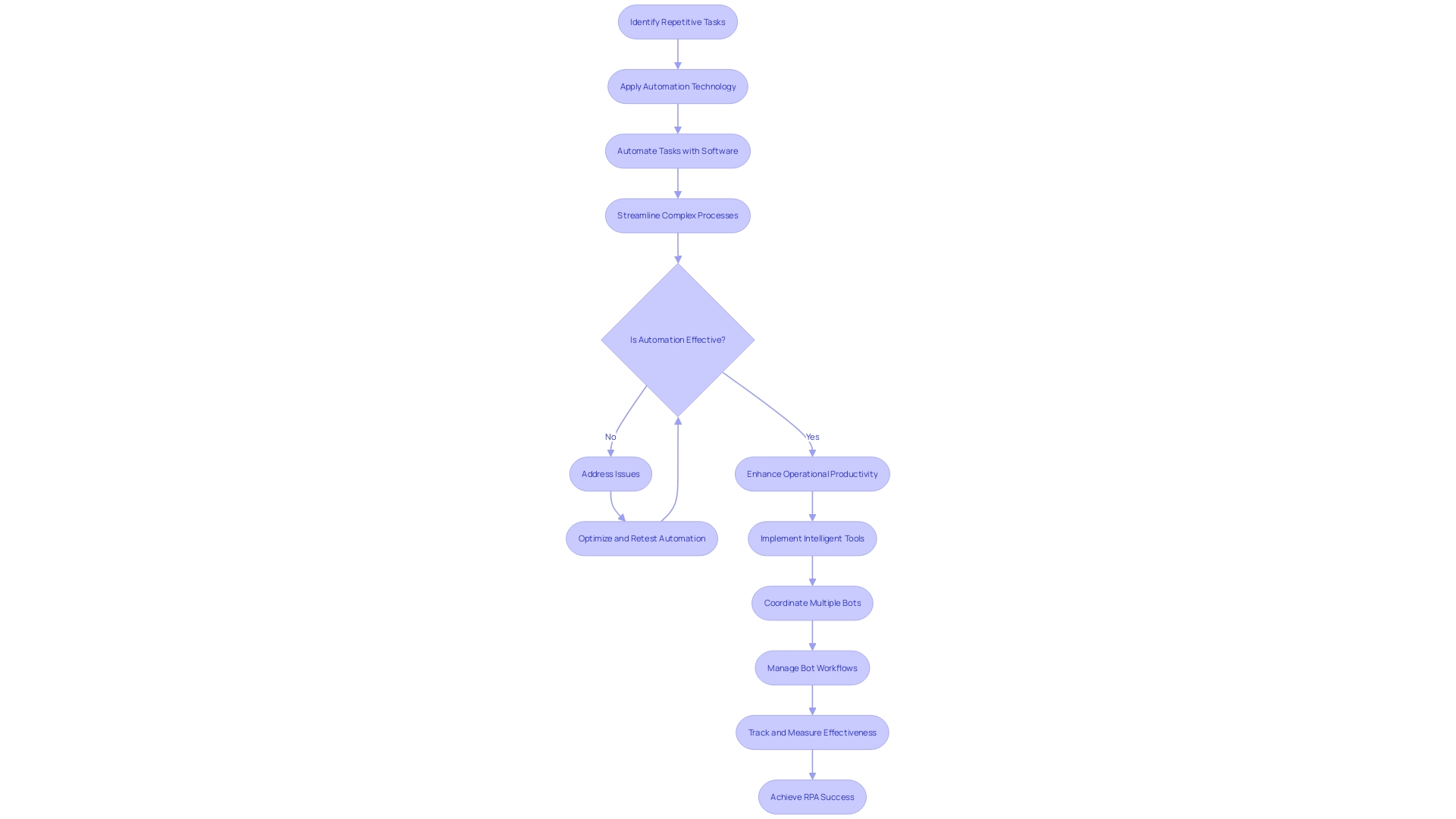
Debugging and Error Handling in RPA
Despite meticulous planning, Robotic Process Automation (RPA) implementation is not immune to challenges. Encountering errors in bot logic or system failures is common. However, the key to successful RPA lies in effective debugging and exception handling.
When a bot encounters an error, it’s essential to have a fail-safe mechanism in place. This might involve setting up actions that only execute upon failure, ensuring the process continues smoothly. An example from the Aspire framework illustrates this approach, where resources are orchestrated to manage failure points proactively.
Moreover, understanding the fundamental principles of debugging is crucial for resolving errors. Issues could range from logic errors to unexpected behaviors, and a systematic approach is necessary to tackle these head-on. Utilizing breakpoints for pausing code execution allows for thorough inspection and problem-solving.
It is also crucial to acknowledge that mechanization, including the use of AI, is not a ‘set and forget’ answer. Continuous monitoring, management, and upgrades are required to maintain stability and efficiency, as emphasized by experts in the field. This human collaboration with tools is critical in ensuring that RPA tools are not only efficient but also resilient.
In the modern business environment, it is crucial to identify manual tasks that can be automated and comprehend their inefficiencies before integration. It’s a strategic decision that involves considering the time and cost implications of deploying RPA solutions.
By incorporating these insights, one can navigate through the complexities of RPA implementation, turning potential stumbling blocks into stepping stones for operational success. The aim is not just to automate for the sake of it but to enhance accuracy and productivity by leveraging the synergy between human oversight and robotic precision.
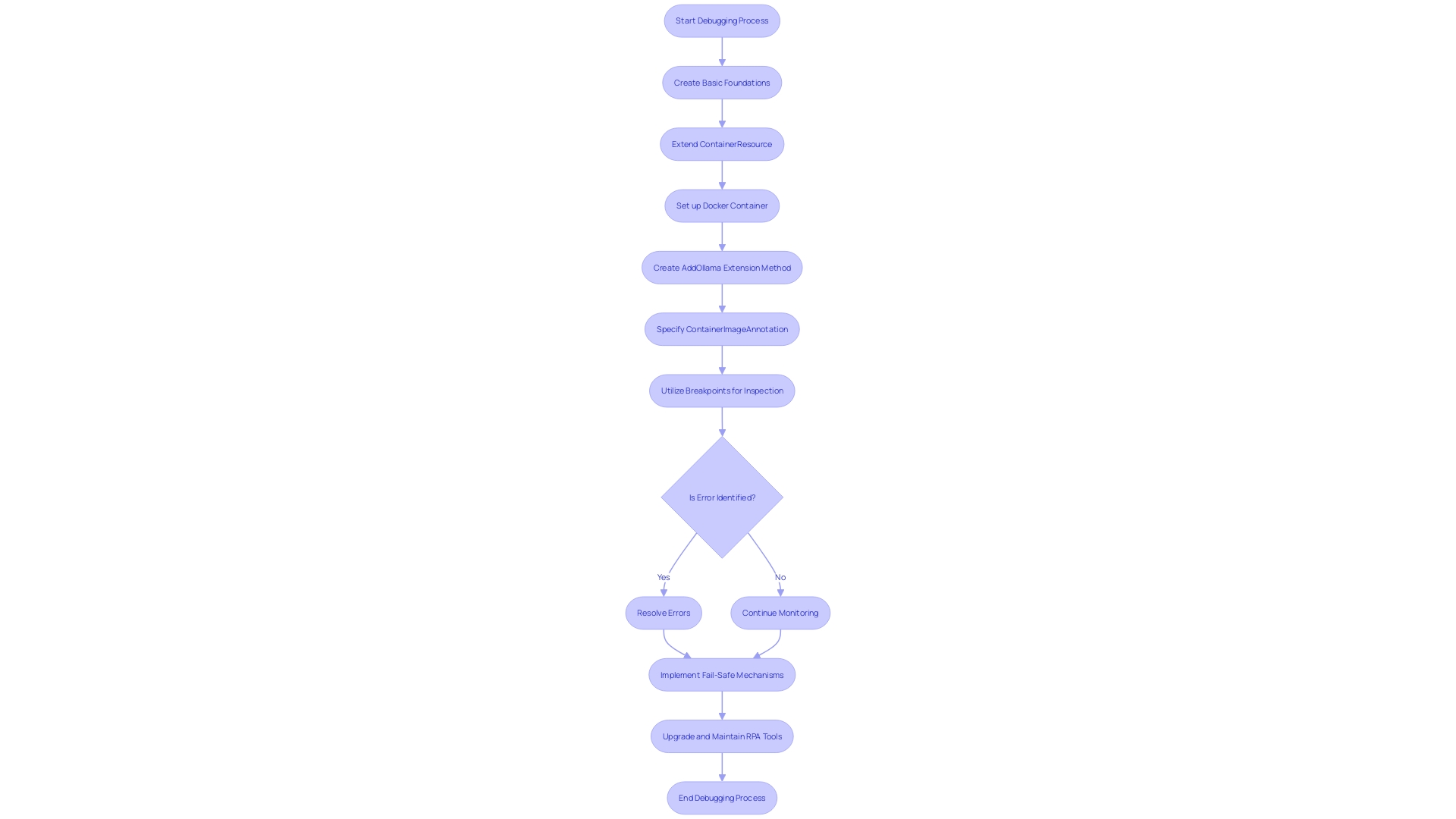
Best Practices for RPA Implementation
Best practices for Robotic Process Automation (RPA) implementation are fundamental to reap the full benefits of this technology. A strategic approach that starts with a thorough comprehension of the particular manual procedures appropriate for automation can lay the groundwork for success. By identifying inefficiencies in current processes, organizations can target their RPA efforts more effectively, ensuring that time and resources are invested wisely. Engaging stakeholders is critical, as their input can reveal existing solutions that may have been overlooked, akin to the NHS’s finding of pre-existing technologies within their trust.
Moreover, change management is pivotal in RPA adoption. As noted by the CTO and Co-Founder of Reveille Software, although automation aims to enhance efficiency and productivity, it is not a ‘set it and forget it’ solution. Continuous monitoring, management, and upgrades are necessary to maintain stability and performance. Governance is crucial in ensuring that RPA solutions adhere to high security and compliance standards, similar to the digital assurance employed by the NHS trust.
Lastly, the path to continuous improvement in RPA is akin to the ‘evaluation loop’ used in prompt engineering. This iterative approach of refining based on measurable success criteria ensures that RPA implementations evolve and improve over time, keeping pace with business needs and technological advancements. By integrating these best practices, organizations can ensure that their RPA initiatives deliver long-term, sustainable success.
Real-World Examples and Case Studies
Exploring real-world applications of RPA, we see organizations like M&T Bank, with its storied 165-year history, embracing the need for high-quality software standards to support its digital transformation amidst today’s tech-driven banking landscape. They’ve set a precedent in maintaining Clean Code standards, crucial for their software’s maintainability, efficiency, and security. Such measures are vital in an industry where introducing problematic software can result in dire consequences, such as security breaches and financial losses.
In healthcare, the integration of digital tools follows a rigorous process, as emphasized by the NHS’s approach where clinicians submit requests for new innovative solutions. These are then assessed for security, appropriateness, and compliance by the Digital Service Team. This rigorous scrutiny often reveals existing technological solutions within the organization, underscoring the value of thorough internal assessments.
Retail is another sector reaping the benefits of RPA, with innovations like the checkout-free store in Dublin Airport. Here, Zippin technology allows customers to enjoy a seamless shopping experience without the wait, proving that RPA can significantly enhance customer satisfaction and operational efficiency.
These cases are supported by intelligent strategies that propose beginning with smaller tasks, establishing a comprehensive tools library, and consistently monitoring and documenting results. This approach not only streamlines operations but also fosters digital transformation through the integration of RPA and AI. The intelligent digitalization lifecycle involves identifying digitization-worthy tasks, stakeholder involvement, and defining digitalization processes, showcasing the systematic progress from concept to reality.
Quotes from industry experts reveal that despite the revolutionary potential of AI and RPA, human oversight remains indispensable. As the study of automated systems has shown, advancements focused on improving effectiveness and output still necessitate collaboration with humans to guarantee steadfastness and applicability to real-life challenges.
The implementation of these advancements is not without its challenges, as companies often face hurdles in aligning the innovations with real problems. The key lies in understanding the underlying issues within an organization’s structure and goals. By prioritizing improvement of their operations, enhancing efficiency, and making informed decisions, companies are more likely to successfully achieve digital transformation with the help of intelligent and advanced technology.
Future of RPA: Trends and Predictions
The realm of robotics task automation (RPA) is rapidly advancing, with emerging technologies like AI-powered mechanization and hyper-automation at the forefront of shaping its future. While organizations contemplate the modernization via automation, it’s essential to assess which manual procedures are ready for automation, the inefficiencies they may contain, and the integration costs of RPA software.
Hyper-automation, which marries RPA with artificial intelligence (AI), is setting a new pace in the development of robotics. This transformative synergy is already making waves across industries, enabling the creation of more customized and optimized solutions. As generative AI continues to capture global attention, its application in businesses remains nascent, with the potential to accelerate the software development lifecycle and reinvent it as a real-time process.
In the realm of AI, the market size is anticipated to swell to US$305.90 billion by 2024, with an impressive CAGR of 15.83% from 2024 to 2030. This growth trajectory indicates a massive adoption curve, particularly in the United States, which is expected to lead with a market size of US$106.50 billion in 2024. The AI market, inclusive of software, hardware, and services, empowers organizations to craft and implement AI-driven applications across various domains such as speech recognition, image processing, and even autonomous vehicles.
Recent implementations of AI, like in UK train stations and the TSA’s facial recognition program, have highlighted both the capabilities and the ethical concerns of the field. These developments highlight the importance of responsible AI deployment, particularly with regards to privacy and bias.
Moreover, the Microsoft 365 Copilot business case, which forecasts a reach of 6.9 million US knowledge workers by 2024, illustrates the convergence of RPA and AI advancements. As Satya Nadella, CEO of Microsoft, notes, the next generation of AI is poised to unlock substantial productivity growth, freeing individuals from mundane tasks to engage in more creative endeavors.
For leaders in the automation space, it’s imperative to construct a robust business case for investment in emerging technologies like RPA and AI. Tools such as the Business Case Calculator For Microsoft 365 Copilot can serve as a starting point, helping to evaluate the potential returns on investment while also recognizing the intrinsic benefits that go beyond mere cost considerations.
As we look ahead, the convergence of past and future technological shifts, including agile, DevOps, low-code, and AI, continues to reshape the software development landscape. Generative AI, in particular, is disrupting traditional paradigms, empowering both seasoned and citizen developers, and heralding a new era of application generation platforms. The promise of AI in setting a new development cadence for robotics is not just a prediction—it’s rapidly becoming a reality.
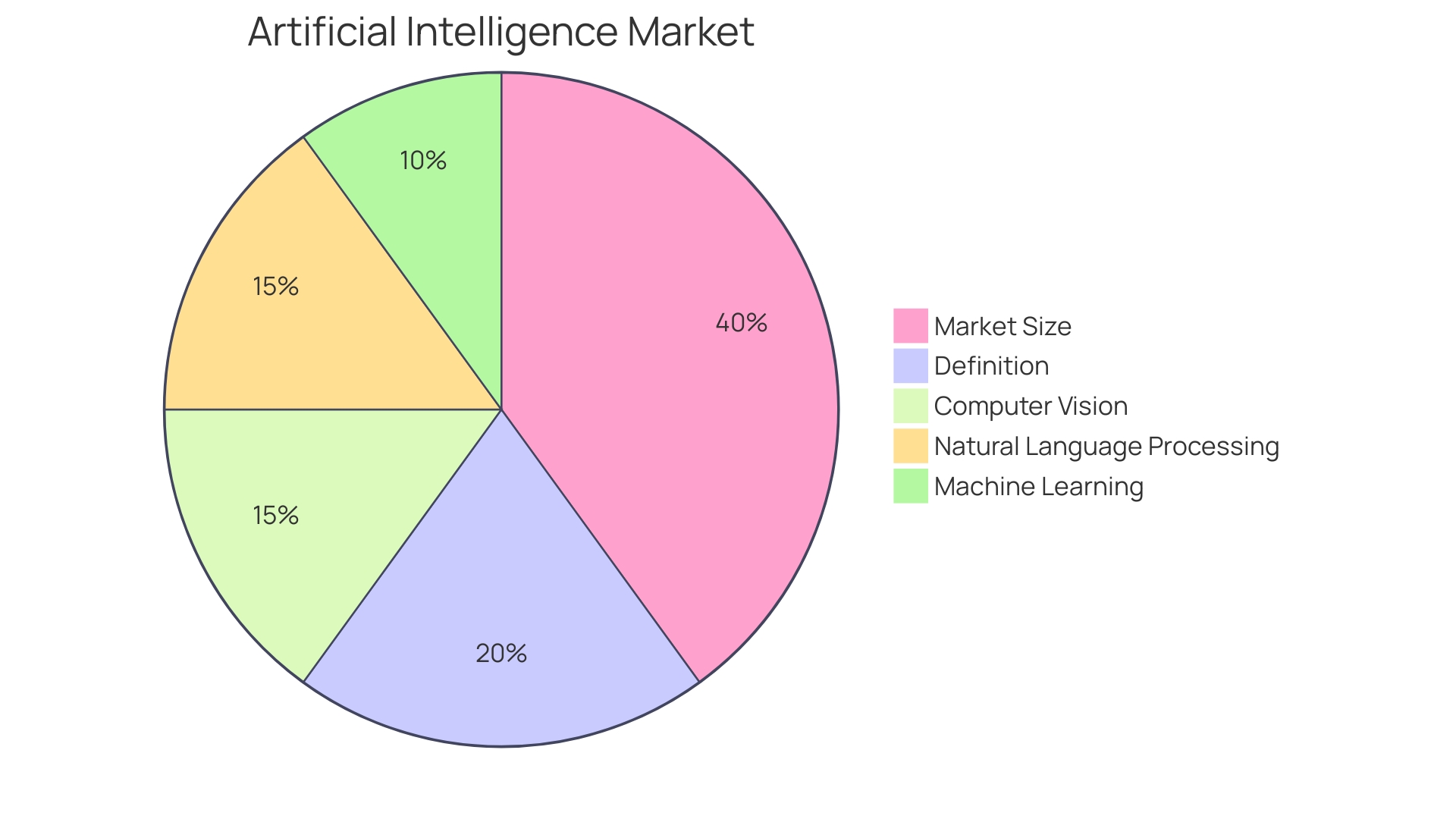
Conclusion
RPA is revolutionizing business operations by automating tasks and streamlining processes for enhanced efficiency. Successful implementation requires careful planning and ongoing monitoring. By leveraging RPA’s capabilities, organizations save time and resources while driving innovation and competitive advantage.
Integrating RPA offers benefits beyond cost savings, enhancing productivity and refining business processes. RPA’s versatility is evident in common applications across industries such as healthcare, customer service, retail, HR, and supply chain management.
Selecting the right tools and technologies is crucial. Advanced techniques like exception handling and error recovery mechanisms enhance automation capabilities. Cognitive automation through RPA and AI integration enables intelligent decision-making and process optimization.
Process discovery and optimization are fundamental, ensuring existing workflows are enhanced. Effective bot orchestration and workflow management ensure coordinated task execution and optimal performance. Best practices include identifying suitable processes, engaging stakeholders, managing change, and embracing continuous improvement.
The future of RPA lies in emerging technologies like AI-powered automation and hyper-automation. Hyper-automation combines RPA and AI for more customized solutions. The market for AI is expected to grow significantly, empowering organizations to implement AI-driven applications.
In conclusion, RPA is a strategic asset for modernizing business operations, saving time and resources, and driving innovation. By following best practices, leveraging advanced techniques, and integrating AI, organizations unlock the full potential of RPA and thrive in the future of work.
Unlock the potential of RPA and drive innovation in your organization today!

